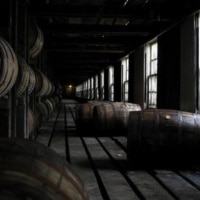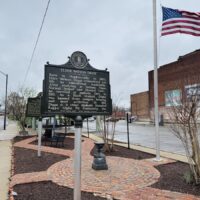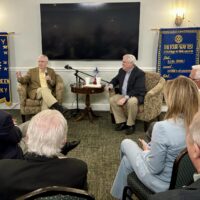This month’s artifact is about as mundane as they come. Every one of us has many of these, and I’d venture to guess that most of us will use one today. It measures almost 6 inches long, and it is silver plated. Thanks to a little help from our friends at J. Schrecker Jewelry, most of its tarnish has been removed to reveal a bit of a shine. Simple and tapered, the handle features a shell pattern and curves up subtly and elegantly at its end. It is engraved with the words “Hotel Latham.”
It’s a spoon – a teaspoon, to be exact. And it was used at one of Hopkinsville’s finest establishments, the Hotel Latham.
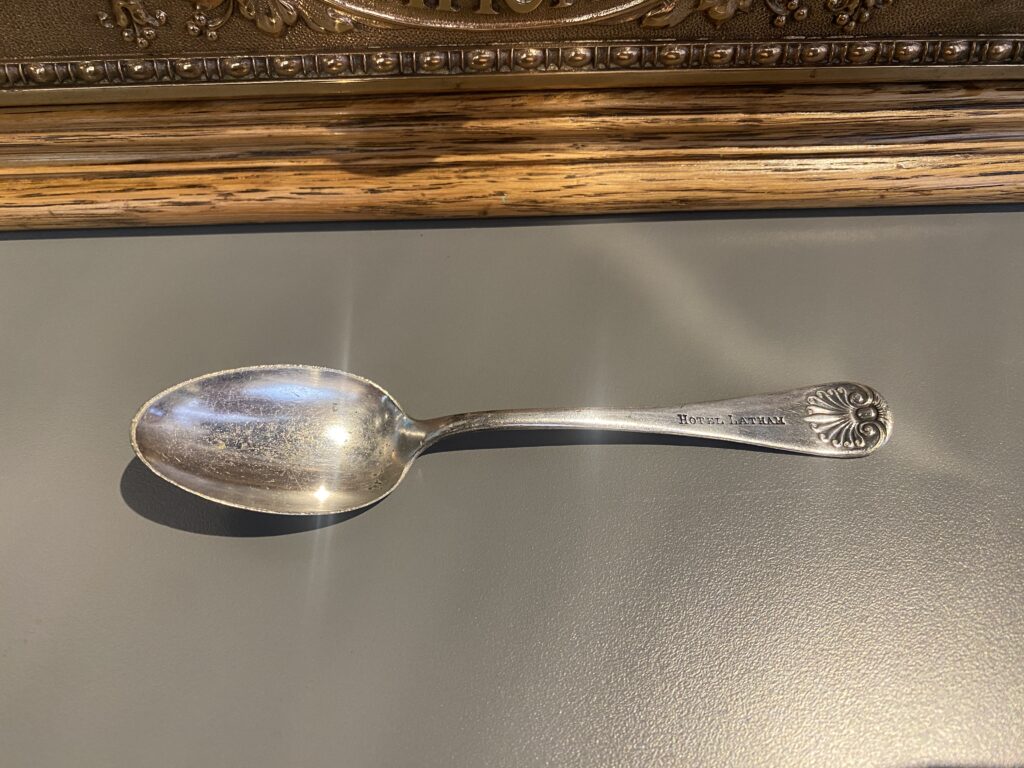
I was drawn to this seemingly simple spoon as I was researching and preparing for the museum fundraiser that we are hosting this Saturday. We are throwing a big gala – inspired by the Met Gala put on by the Metropolitan Museum of Art every spring in New York City. The theme is “Metamorphosis” – focusing on the major changes that occurred in the decade of the 1910s. The evening features a cocktail hour, live music and dinner. (Tickets are available here.)
We want the event to pull from local history in every way possible – including the menu for dinner. Lucky for us, the newspaper printed detailed lists of dishes and courses from parties and banquets at the Hotel Latham. (Unfortunately, we have yet to find a printed menu from the hotel dining room’s regular menu.)

The Hotel Latham is easily one of the most storied buildings in our community’s history. It was grand. It was expensive. It was the center of cultural activity. And it was dramatically removed from our streetscape in a devastating fire. There are numerous pictures and postcards that show the pale yellow brick, carved details, and red slate roof of its exterior – and images of the lobby and barbershop that operated on the first floor. Most importantly to our spoon, there are also photographs of the hotel’s dining room.
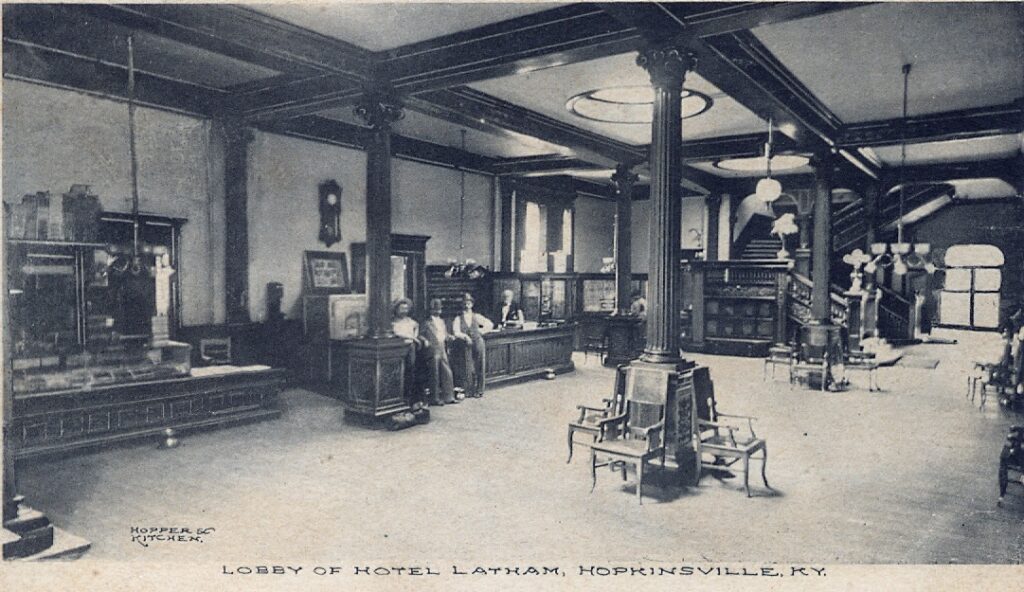
Named for John C. Latham Jr., the Hotel Latham was constructed in 1894 and opened right after the new year in 1895. The Hopkinsville Kentuckian ran a detailed report of the hotel’s amenities prior to the grand festivities that announced it open for business. Within this description, we find information about the dining room – stating that it seated 150 people with the ability to seat 50 or more in an adjoining room. “There is nothing handsomer in any hotel in the South,” the article stated.
I am most intrigued by the description of the kitchen. The designers of the kitchen duplicated that of the Planters Hotel in St. Louis with great extravagance. The range – described as “mammoth” – measured 13 ½ feet long, featured three ovens, a 36 inch broiler, and a separate baking oven. The article continued: “There is a hood over the whole cooking arrangement, which carries all the fumes up the flues and keeps the room free of odors. A steam table 16 feet long has warming pans for eight vegetables, two soups and six dishes, also a plate heater. There is a steam jacket for making soup, and the kitchen is equipped with sauce pans and other utensils equal to any Chicago hotel.”
What a setup!
The chefs & their menus
The hotel employed an executive chef who had 25 years experience in well-known hotels from the Galt House in Louisville and the Maxwell House in Nashville to other leading hotels across the country. Born in France around 1860, Henri Rigoulot appears to have come to Hopkinsville via Nashville, and menus from the first decade of the hotel’s life show heavy influences from his French culinary background.
The earliest menu found in the newspaper was printed on Jan. 11, 1895, barely a week after the hotel opened its doors. The event was a huge wedding uniting the children of two Jewish families. Dinner was served to 162 people – all who were able to dine at the same time. The menu included multiple courses and was said to last three hours. The courses were as follows:
- First course: raw oysters, celery, salted almonds, and Spanish olives
- Fish course: broiled salmon, a la Maitre de Hotel and Saratoga chips
- Roast course: turkey, oyster dressing, cranberry sauce, and baked mashed potatoes
- Relief course: Roman punch
- Game course: stuffed mallard duck, French peas, chicken salad, and shrimp salad
And that was all before dessert! The hotel also employed a baker named Gus Eckhardt who had more than 20 years experience at Ward’s School in Nashville as well as at leading hotels. Eckhardt was presumably in charge of the dessert course that featured bridal cake, assorted cakes, vanilla ice cream, strawberry ice cream, assorted fruits, French coffee, crackers and Edam cheese. Wines were also served at intervals throughout the banquet.
Now, that’s a party!
Chef Rigoulot’s French style remained prevalent through the early 1900s, but by the 1910s, the menus represented a more localized cuisine. Country ham, beaten biscuits, fresh tomatoes (with mayonnaise dressing) and “new potatoes in balls” make frequent appearances on dinner plates in the Hotel Latham dining room. I haven’t figured out who took over after the French chef, but it does appear that he was back in Nashville by 1910 (if not before).
Top-notch service
The chefs and the guests in the dining room were not the only ones who handled this spoon – and hundreds of others just like it. The hotel was known for its superior serving staff that provided an elegant, top-notch experience for diners. In that same article that identified Rigoulot as the hotel’s first chef, the name of the head waiter and eight servers are also listed. Tom Vaughn served as the head waiter with Scott Woosley, Nelson Meacham, John McCombs, Peter Bronaugh, John Brewer, William Howard, Joe Monroe and Ernest Oldham rounding out the wait staff. Quick searches on Ancestry.com reveal that these were all African American men.
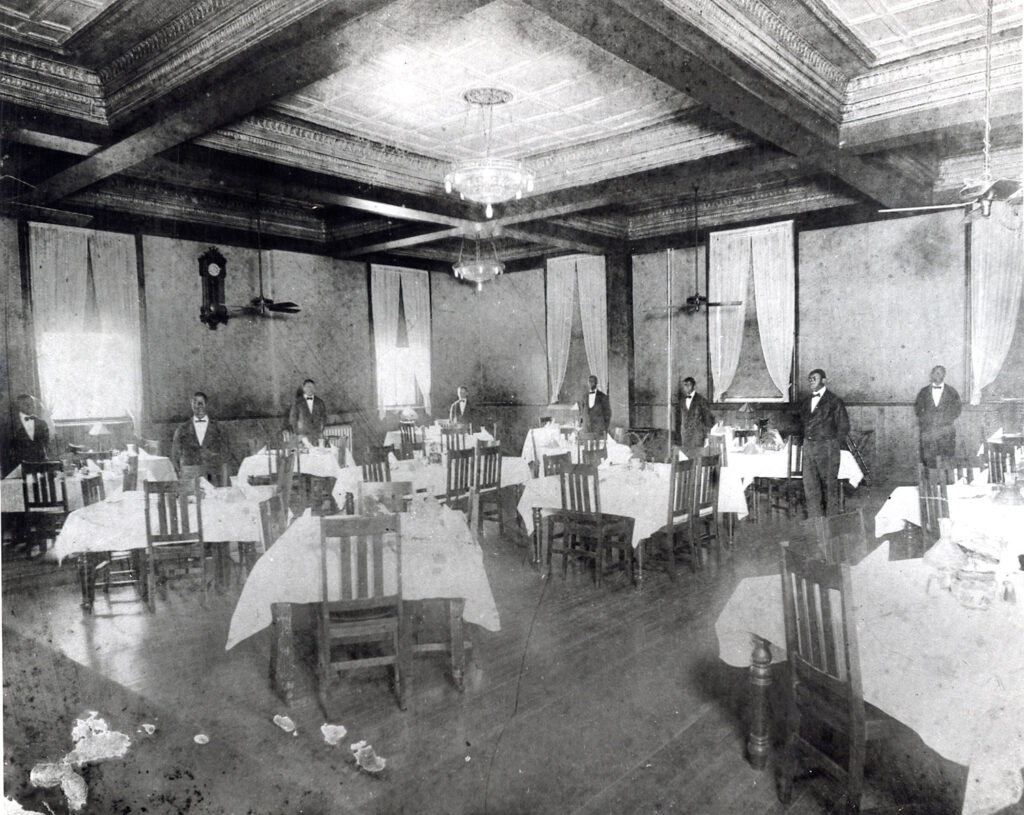
A spoonful of history
But back to our spoon. The underside of the handle is engraved with the mark 1847 Rogers Bros. I hunted and pecked around the internet to figure out when this pattern might have been available. My best – and only – guess was found on an extensive replacements website that had pages and pages of Rogers Bros. silverware patterns. Our Hotel Latham teaspoon is of the Shell pattern from as early as 1860 – meaning the style was available from the opening days of the hotel.
The soups in which this spoon has been dipped. The coffee that it has stirred. The bites of ice cream that it has scooped. The hands that have washed it, set it and held it. The mouths that have touched it. This little spoon holds so much more than a teaspoon of stories!
This little spoon served as an inspiration for the menu at the museum’s gala this weekend. Hancock’s Catering out of Cadiz is preparing a meal that reflects on our past – with dishes that also feel like home. The spoon itself is on display at the Pennyroyal Area Museum now as a reminder of all the people who have gathered, mingled, shared stories, and enjoyed a meal together in Hopkinsville.
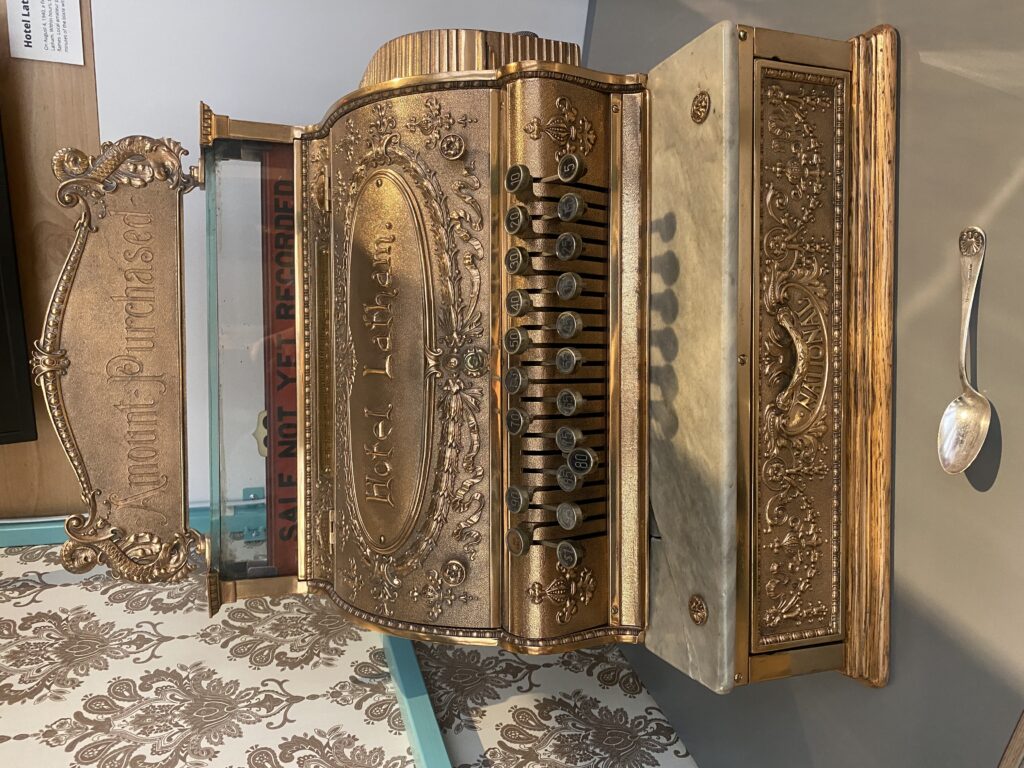
Alissa Keller is the executive director of the Museums of Historic Hopkinsville-Christian County. She’s a graduate of Centre College with degrees in history and English and of Clemson University/College of Charleston with a master’s degree in historic preservation. She serves on the Kentucky Historical Society and the Kentucky Museum and Heritage Alliance boards.
